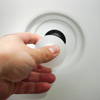We may earn commissions when you buy from links on our site. Why you can trust us.

Apple to Fix Misleading iPhone Reception Bars
by Josh Kirschner on July 02, 2010
In an interesting twist on the widely reported issues with reception on the iPhone 4, it turns out that gripping the phone a certain way doesn't reduce reception significantly—you just never had good reception in the first place.
According to a press release today from Apple, they have been using an incorrect formula to calculate how many bars should be displayed on the iPhone. Phones may be showing four or five bars when they should only have two or three. This issue predates the iPhone 4 and, in fact, occurs in every iPhone since the original.
Apple will release a software fix for the problem in the next few weeks. The fix won't actually do anything to improve reception, it just provides a more accurate representation of what reception you're getting from AT&T in your area.
And, to compensate for fewer bars appearing on your phone, Apple will be making bars 1,2 and 3 taller. Which is vaguely reminiscent of the amplifier in the movie Spinal Tap with a dial that went to 11 because, you know, regular dials only go to 10, so 11 is louder...I guess taller bars give the impression of better reception.
The good news is that, according to Apple's testing, the reception on the iPhone 4 is better than the iPhone 3G S. And, the iPhone is a great phone for many other reasons. AT&T reception just isn't one of them.
The full press release is below.
Letter from Apple Regarding iPhone 4
Dear iPhone 4 Users,
The iPhone 4 has been the most successful product launch in Apple’s history. It has been judged by reviewers around the world to be the best smartphone ever, and users have told us that they love it. So we were surprised when we read reports of reception problems, and we immediately began investigating them. Here is what we have learned.
To start with, gripping almost any mobile phone in certain ways will reduce its reception by 1 or more bars. This is true of iPhone 4, iPhone 3GS, as well as many Droid, Nokia and RIM phones. But some users have reported that iPhone 4 can drop 4 or 5 bars when tightly held in a way which covers the black strip in the lower left corner of the metal band. This is a far bigger drop than normal, and as a result some have accused the iPhone 4 of having a faulty antenna design.
At the same time, we continue to read articles and receive hundreds of emails from users saying that iPhone 4 reception is better than the iPhone 3GS. They are delighted. This matches our own experience and testing. What can explain all of this?
We have discovered the cause of this dramatic drop in bars, and it is both simple and surprising.
Upon investigation, we were stunned to find that the formula we use to calculate how many bars of signal strength to display is totally wrong. Our formula, in many instances, mistakenly displays 2 more bars than it should for a given signal strength. For example, we sometimes display 4 bars when we should be displaying as few as 2 bars. Users observing a drop of several bars when they grip their iPhone in a certain way are most likely in an area with very weak signal strength, but they don’t know it because we are erroneously displaying 4 or 5 bars. Their big drop in bars is because their high bars were never real in the first place.
To fix this, we are adopting AT&T’s recently recommended formula for calculating how many bars to display for a given signal strength. The real signal strength remains the same, but the iPhone’s bars will report it far more accurately, providing users a much better indication of the reception they will get in a given area. We are also making bars 1, 2 and 3 a bit taller so they will be easier to see.
We will issue a free software update within a few weeks that incorporates the corrected formula. Since this mistake has been present since the original iPhone, this software update will also be available for the iPhone 3GS and iPhone 3G.
We have gone back to our labs and retested everything, and the results are the same— the iPhone 4’s wireless performance is the best we have ever shipped. For the vast majority of users who have not been troubled by this issue, this software update will only make your bars more accurate. For those who have had concerns, we apologize for any anxiety we may have caused.
As a reminder, if you are not fully satisfied, you can return your undamaged iPhone to any Apple Retail Store or the online Apple Store within 30 days of purchase for a full refund.
We hope you love the iPhone 4 as much as we do.
Thank you for your patience and support.
Apple








